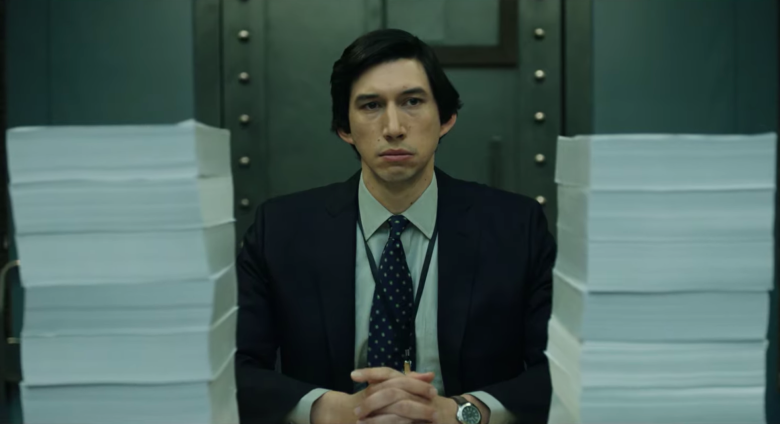This op-ed by Clive Stafford Smith was originally published in the New York Daily News, on November 15, 2019.
Great drama sometimes takes place on an unexpected stage. So it is with The Report. How dry it must have felt to focus on Daniel J. Jones, the Senate staffer played by Adam Driver. Working for California Senator Dianne Feinstein (Annette Bening), Jones spent five years in a windowless room at the CIA, poring through documents related to Agency’s torture program. His report on the use of what the CIA called ‘Enhanced Interrogation Techniques’ (EITs) remains the most thorough account of this shameful abandonment of American values.

Facing unwelcome exposure, the CIA naturally played dirty. Crucial documents disappeared, including the Agency’s own damning assessment that torturing detainees was not producing “actionable intelligence”. The investigation’s office was bugged, to find evidence to prosecute Jones and delegitimise his work. Feinstein defended him, only for President Barack Obama to suppress the full 6,700-page report and release a heavily-redacted 499-page ‘Executive Summary’ of the findings. He wanted to “move onwards”.
The Report achieves the rare feat of depicting an important event accurately and watchably. I say this from experience, having spent much of my time since the horrific events of 9/11 reviewing classified records of tortured prisoners in the so-called ‘Secure Facility’ for Guantánamo Bay material. Such films are important as they bring history to a wide audience, and if we do not learn from our mistakes, we are doomed to repeat them. That President Donald Trump can say waterboarding is not “tough enough” and earn a round of applause should worry us all.
The film depicts Abu Zubaydah’s waterboarding in unflinching close-up. The Spanish Inquisition called this technique tortura del agua (“water torture”). It was first termed Verschärfte Vernehmung, or “Enhanced Interrogation”, by the Gestapo in 1937. When the war concluded, the Allies deemed it a war crime, punishable by hanging.
The CIA initially touted Zubaydah as a big catch, number three in Al Qaida after Osama Bin Laden and Ayman al Zawahiri, and tortured him into admitting it. They were never going to admit their mistake: at Guantánamo, they had Zubaydah designated a “Forever Prisoner” and put him in Camp Seven, hidden from public view. Jones exposed the lie.
At one point in The Report, a would-be whistleblower accosts Jones in a car park. The camera watches while Jones teeters on the edge of a nervous breakdown as he processes the horrors being described. As someone who has represented 88 Guantánamo detainees and heard them describe the barbarous things that were done to them in the name of defending America, this rings true.
The suspected terrorists rounded up by the CIA in the early years of the ‘war on terror,’ many of whom were innocent men sold for bounties, were subjected to an array of tortures: they were waterboarded, slammed against walls, confined in coffin-sized boxes, threatened with dogs, guns and power drills, raped under the guise of ‘rectal rehydration,’ slashed with razor blades, blasted with deafening music and forced to stand with their arms shackled overhead until their shoulders dislocated. Most suffer PTSD as a result of the torture they endured. Having heard about it in graphic detail, so do I. It wouldn’t surprise me if Jones does, too.
The Report tells the truth, but not the whole truth. It is not the fault of the film, for there is enough irony and trauma in the torture program for a ten-part series. One of my clients, Karachi taxi driver Ahmed Rabbani, was tortured in the Dark Prison for over 540 days – bizarrely, one of the redactions in the Executive Summary is the last number (“54X”), so Ahmed is not allowed to know whether he suffered for 540 or 549 days in total.
He was assumed to be arch-terrorist Hassan Ghul, which he strenuously denied from day one. What he didn’t know – and only discovered when he was permitted to read the sections of the report relating to his own torture – was that the CIA recognized their error on the second day of his ordeal. More horrifying still, Ghul was captured and brought to the same prison, but released after two days because he was “cooperative” – presumably he admitted who he was.
In its dramatic depictions of torture, the film makes up in a very small way for an extraordinary omission in the Senate’s work: the victims. The report is surely the first in-depth inquest into governmental wrongdoing where no effort was made to speak to those who suffered. Many were readily available in their cells in Guantánamo, held without charges for more than a decade.
The story is not yet complete. Perhaps we can hope that The Report will reinvigorate interest in this dark era of American history, and inspire us to publish the full truth.